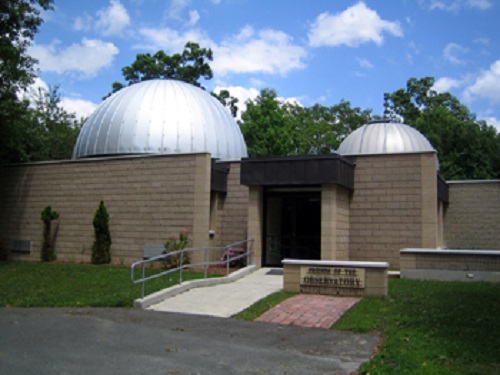
Saturday evening programs continue from Sept. 10 through Dec. 3
The Western Connecticut State University Planetarium and Observatory will offer seven Saturday evening shows and viewings of the autumn sky from Sept. 10 through Dec. 3 in public nights to be held at the facility on the university’s Westside campus, 43 Lake Ave. Extension in Danbury.
Each WCSU Observatory public night will present an hourlong planetarium show followed by telescope viewing of the moon, planets and prominent star clusters and galaxies visible during the autumn months. The Observatory, located atop a hill near Pinney Hall on Western’s Westside campus, offers viewings through a 20-inch, computer-controlled Ritchey-Chretien reflector telescope.
Admission will be free and the public is invited. Limited parking is provided adjacent to the observatory, with additional parking available on University Boulevard. WCSU Observatory public sky viewings are subject to cancellation in the event of cloud cover or inclement weather; planetarium shows will be canceled only due to severe weather or hazardous road conditions. Cancellation updates are available on the day of the event by calling (203) 837-8672.
WCSU Planetarium and Observatory public nights during the fall semester will include:
- Sept. 10: The planetarium show will start at 7 p.m., with sky observation following from 8 to 10 p.m. Visible objects will include the moon nearing first quarter, the M13 star cluster, the Epsilon Lyrae star system, the Ring Nebula and the double star Albireo.
- Sept. 24: The planetarium show will start at 7 p.m., with sky observation following from 8 to 10 p.m. Visible objects will include Neptune, Epsilon Lyrae, Albireo, the Andromeda galaxy, and the M2 and M15 star clusters.
- Oct. 8: The planetarium show will start at 6 p.m., with sky observation following from 7 to 9 p.m. Visible objects will include the moon nearing first quarter, Venus, Neptune, Albireo, Andromeda and the M2 and M15 clusters.
- Oct. 22: The planetarium show will start at 6 p.m., with sky observation following from 7 to 9 p.m. Visible objects will include Venus, Neptune, the Perseus double cluster, Andromeda and the M2 and M15 clusters.
- Nov. 5: The planetarium show will start at 5 p.m., with sky observation following from 6 to 8 p.m. Visible objects will include the waxing crescent moon, Venus, Neptune, Andromeda, the Perseus cluster and the M2 and M15 clusters.
- Nov. 19: The planetarium show will start at 4 p.m., with sky observation following from 5 to 7 p.m. Visible objects will include Venus, Uranus, Neptune, Andromeda, the Pleiades star cluster and the M2 and M15 clusters.
- Dec. 3: The planetarium show will start at 4 p.m., with sky observation following from 5 to 7 p.m. Visible objects will include the crescent moon, Venus, Uranus, Neptune, Andromeda, the Pleiades and Perseus clusters, and the M2 and M15 clusters.